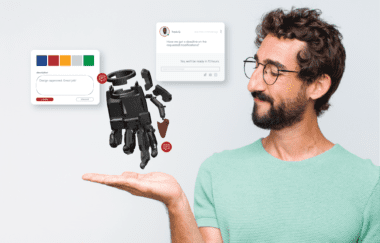Effective Communication – The Start-Up’s Biggest Challenge
 If you were looking for a dose of optimism to counter the troubling reality of the post-pandemic world, you could do a lot worse than turn to the start-up community. Even in the best of times, the odds are stacked ruthlessly against anyone considering starting a business. And these are hardly the best of times. Yet new ideas and the magic combination of hope and conviction that supports them, continue to pour forth in a torrent. According to the U.S. Census Bureau, Americans started 4.3 million businesses in 2020, a 24% increase from 2019, and by far the biggest number in a calendar year in the previous decade and a half.
If you were looking for a dose of optimism to counter the troubling reality of the post-pandemic world, you could do a lot worse than turn to the start-up community. Even in the best of times, the odds are stacked ruthlessly against anyone considering starting a business. And these are hardly the best of times. Yet new ideas and the magic combination of hope and conviction that supports them, continue to pour forth in a torrent. According to the U.S. Census Bureau, Americans started 4.3 million businesses in 2020, a 24% increase from 2019, and by far the biggest number in a calendar year in the previous decade and a half.
As an investor, and a mentor for Creative Destruction Labs (CDL) I meet a lot of founders, and I watch a lot of introductory pitches. And while the enthusiasm is ever-present, it is not uncommon, after the founder has left the room, for those who have just watched the pitch to turn to one another and say something like: “I still don’t know what they actually do.”
The effective communication of a new product’s value and function is, I believe, the biggest challenge facing any start-up founder. This is about knowledge transfer. It is a prerequisite of every progressive step the company hopes to take. And it is particularly difficult for companies that are bringing to market – either as a core product or as part of a wider service or solution – a complex mechanical object (CDL focuses on science and technology start-ups).
These founders have to convince investors to fund their project; they have to explain defensible intellectual property to patent attorneys and granting authorities; they have to communicate requirements to sub-component suppliers and manufacturing partners; they need to convince buyers and users that the product can deliver; they must ensure anyone responsible for maintenance and repair knows exactly what’s required to keep it operational.
That is a broad audience, each with a specific set of knowledge transfer needs. So to be effective, communication needs to be highly versatile, and to deliver absolute clarity through the most efficient processes. If this capability isn’t baked into the organization from the outset, the best case scenario is that the challenge scales as the company becomes successful, creating a much bigger problem which can have a direct impact on operational KPIs.
As products come to market they bring with them a host of documentation and content requirements associated with that knowledge transfer. Creating and maintaining this content is a huge task and one that can easily become a bottleneck. If the content isn’t ready, the product can’t be promoted or sold. If it isn’t completely accurate, if it’s hard to access, if doesn’t tell the full story, you could be looking at fabrication or maintenance errors and costly downtime.
Advances in manufacturing technology – the adoption of agile workflows and additive manufacturing – actually make things worse. These processes accelerate product development and iteration, making the documentation and content bottleneck even more damaging.
Macro realities compound the problem yet further. Once upon a time a new company would start by bringing a core team together at a new premises. However, full-time, on-site work looks like a thing of the past. Studies suggest 70% of the workforce will remain working remotely five days per month by 2025 with others opting to work part-time on-site and part-time at home. And, in any case, start-ups tend to rely on a distributed ecosystem of product and service suppliers from the outset, for obvious reasons.
And according to a 2020 McKinsey report, Unlocking growth in small and medium-size enterprises, SMEs have innate productivity challenges, exacerbated by lack of access to high-cost enterprise software solutions. So, to ensure effective communication – to give themselves the best possible chance of success – start-ups today must find a way to drive effective teamwork and collaboration among a distributed workforce and ecosystem, at an affordable price point, all while driving productivity, in order to become competitive.
No pressure.
But start-ups have an advantage. Their primary strength in addressing these challenges is their capacity for continuous innovation, not just in terms of products and services but also – crucially – in terms of processes. This owes a huge amount to that optimism which got them started on the journey in the first place. According to McKinsey, “Because they are unhindered by legacy systems and outdated strategies, new market entrants are often able to rethink established practices and cut through traditional industry boundaries.”
Here’s a great example: Impossible Sensing is a CDL alumnus that develops and manufactures autonomous exploration tools designed to function in extreme environments from deep ocean to deep space. Their products are used to detect valuable minerals in off-planet environments. Prior to the pandemic, Impossible Sensing’s founder used 3D-printed models to enable prospective buyers – a Mars scientist at NASA, for example – to get a tangible sense of the firm’s products.
Restrictions on face-to-face meetings put an end to that, leaving this CEO suddenly missing a key part of his sales pitch. He overcame this by using interactive 3D communication which allows customers to play with the 3D models of his product (the closest thing to handling that 3D-printed object) wherever they were located. Video calling is great for replicating the conversation, but there are a number of critical communication experiences that it simply cannot deliver.
Many people might have focused on the frustration of being unable to continue to operate as they had before. But the start-up’s optimism will always find another way.
A start-up’s Big Idea is only as good as the extent to which it can be understood by everyone whose participation is required to make it successful. Get in front of that effective communication challenge as early as possible – solve that knowledge transfer problem across the board – and not only will you be giving yourself the best possible shot at success, you’ll be future-proofing your business against problems which can undermine you as you grow.
 About the author:
About the author:
Patricia Hume is Chief Executive Officer of Canvas GFX.
